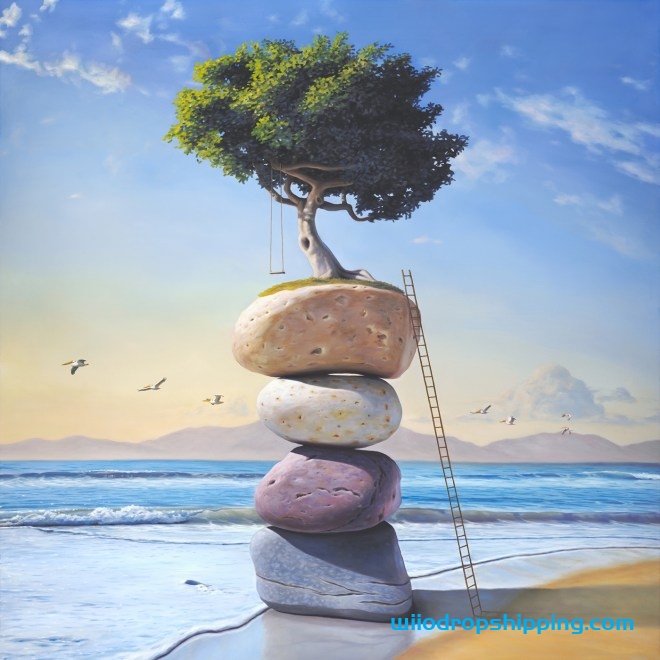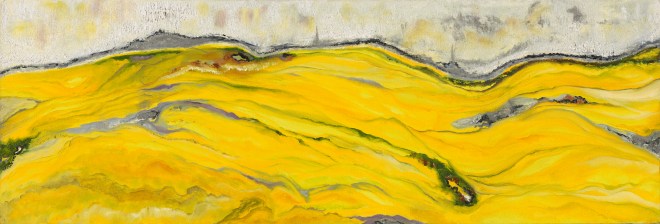Physical Address
304 North Cardinal St.
Dorchester Center, MA 02124

Why?
It used to be that if you sold a piece, that’s it, it’s gone. The buck stops there and only one buyer gets to appreciate your work.
But with prints, that’s not the case at all! Not only do you see more reward from a piece you put so much time and effort into, but you are able to reach even more art buyers who may have loved the original work but couldn’t necessarily afford it.
With the rise in popularity of prints, it’s worth looking into for your art business strategy. Here’s what you need to know to start creating and selling reproduction prints.
As art business consultant Laura C. George puts it, “prints” refer to any sort of reproduction of a piece of artwork. Loosely put, prints can include the art of printmaking, which uses a flat plate to create multiple artworks, such as with lithographs, monotypes, screenprints, etc. These traditional printmaking techniques are generally regarded as fine art prints and artists who work within these mediums are skilled in the craft of printmaking.
However, if you are looking to make prints of your original artwork, you are looking for what is known as giclee print (pronounced “zhee-clays”). Giclees can be used to reproduce many different types of art.
Giclee is a French term meaning “to spray”, referring to how an inkjet printer works and how giclee prints are usually produced. These large format inkjet printers use small spraying devices that can both match color and apply ink precisely, giving artists a high-quality print of their original art explains ThoughtCo.
But, not all inkjet printers produce giclee prints. It all boils down to these four elements: resolution, ink, paper, and printer type.
To be able to make such a high-quality print, the camera or scanner used to capture or scan the art must be able to do so with a high level of resolution. To compare, most digital photos are recorded at a resolution of 72 DPI on the screen, or “dots per inch,” and the image file of an art print needs to be at least 300 DPI—because the more dots of color that can be printed in a small area, the more detailed your final image will appear.
As far as ink and paper go, CreativeBloq clarifies that they must be high quality and considered “archival.” This is typically achieved using inks that are pigment-based instead of dye-based and any canvas, watercolor paper, or specialty printing paper designated as archival. Printers are typically larger models that are able to hold up to 12 ink cartridges which produce a wider range of colors for duplicating your artwork.
Artists have the option to create either open edition or limited edition prints. With open editions, a number of prints that can be created and sold are unlimited, offering artists a constant source of possible revenue.
On the other hand, the number of limited editions is carefully chosen and no more can be created after they are all sold. Of course, this does make limited edition prints more valuable in the eyes of a collector, so artists are able to charge more for this type of print.
“As the online demand for original artwork prints quadrupled in the past years, so did the community of individual artists that wish to sell their art as open edition online,” says Dan. M of ElephantStock.com, a leading provider of on-demand wall art prints.”
“Like many services in the industry, the ElephantStock.com platform is helping artists by giving them great online exposure. At the same time, we make it easier for interior designers and individual customers to discover new and inspiring artworks that match their home decor,” Dan adds.
The open edition model has become a steady income revenue stream for many artists in 2020 and is expected to increase in the coming years as home decor online market demand grows.
Luckily for artists, printers are becoming better than ever in terms of quality. Nowadays, they’re even able to produce high-quality art prints on metal, like Displate does!
When it comes to finding a reputable printer for your giclee prints, make sure you do your research. Ask other artists in your community who they recommend, then feel free to visit those studios, speak with the printers, and look at samples of their work.
Reliable equipment, technical skill, and envisioning a long-term working relationship are a must.
With the help of your printer, your artwork will be scanned or photographed, then an “artist’s proof” is printed. Once you approve that the print matches the original artwork to your liking, a production file is typically created with all the details pertaining to color, density, paper finish, print size, white space as a border, and so on locked in place for identical printing.
In some cases, when a limited edition is sold out, the proofing and production files for that print are erased to keep the integrity of the edition intact for buyers.
If you choose to go limited with your prints, you will quickly be asking yourself the question, “How many limited edition prints should I make?”
There is no right or wrong number. It could be five or it could be five hundred! Either way, you need to carefully consider before signing off with your printer. Remember, the fewer editions there are, the higher price you will be able to ask and the more valuable prints are to buyers. But certain types and sizes of art with a larger number of editions might be a better fit for your target customers.
So, ask yourself, what kind of customer am I trying to reach? Where does this fit in with my other offerings and price points? And, how many editions do I think I’ll be able to sell?
After considering how editions fit into your sales strategy, you will have a better idea of the demand from your customers, how valuable you need to market them as, and therefore how many you want to be able to offer.
As with all artwork, pricing your fine art prints will depend on your career level, covering the costs of creating the work, the profit you wish to make, and what your target customers are willing to pay—all while keeping in mind the number of editions you will be selling. Digital printmaker Old Town Editions offers more pricing tips and a giclee pricing chart here.
Since they’ll be a lower price point than your other work, try offering them in tandem with your originals at art fairs, exhibitions, to emerging collectors, or to those enthusiastic fans who truly find originals too expensive. Galleries and wholesale shops may consider selling prints as well.
Another option is to then use these high-quality images of your art for licensing or merchandising purposes. Many talented fine artists like Robin Maria Pedrero and Tyler Wallach have found success with this opportunity. Check out their advice for interested artists here.
Make sure to inform your buyers that what they are getting is a print and that’s why they can remain at a lower price point—the last thing we want to do is make a customer think they are getting an original or devalue the work of an original piece. However, there is nothing wrong with using your own imagery in reproductions to add to your sales.
To uphold the quality of a true giclée, the resolution must be at least 300 dots per inch (DPI). Think about when you zoom in on a photograph. The more you zoom in, the more distorted the image becomes. To maintain the integrity of the work, you must increase the DPI because the more dots there are in a small space, the more detailed the final product becomes.
The next aspect to consider is what printer is used to print your giclée. The type of printer used to produce a giclée print will impact the quality of the end product. Technical skills and stable equipment can make or break the giclée. Additionally, check the ink of the printer. The ink used for a giclée printer should be pigment-based, while a lower grade inkjet printer will use dye-based ink.
Lastly, do your research. It is important to identify the medium that you want to have your giclée printed on. You have the choice of buying a giclée on archival paper or canvas. For giclée printing, the paper must be archival quality to ensure the longevity of the artwork. Canvas is essentially a fabric that has been specially prepared to handle and retain high-quality pigmented inks. It is sturdy and has archival properties, like archival paper, which means it is acid-free and will hold up to the standards set for a giclée.
Having difficulty deciding between buying a giclée on paper or canvas? Here is a quick guide to help your decision.
There are three factors to consider when choosing between archival paper and canvas for giclées: price, matting/framing requirements, and embellishment.

In terms of price, printing on paper is generally about half the price of printing on canvas. As to be expected, the thicker, fabric-type material of high-quality canvas is more expensive than that of high-quality paper. The process necessary to create giclée prints on paper is less intensive and therefore more budget-friendly.
In addition, you must take into account the cost of protecting and framing the artwork. To maintain the integrity of a giclée print on paper, it is important to protect the work behind glass. An acid-free mat and quality-frame are recommended as well, which oftentimes are more expensive than the giclée itself. With a canvas print, it is not necessary to have a protective pane or frame to hang it. Depending on your aesthetic preference, you have the choice to hang the canvas free of frame, with a traditional frame, or with a modern floating frame. A floating frame is exactly what it sounds like: there is a small gap between the canvas and the frame edges, which creates the illusion of a floating giclée within the frame.

Finally, there is the option to have your giclée embellished. Embellishments are artistic alterations made by artists to the giclée print to customize the piece. Only canvas prints can be embellished and, because of this, canvas prints tend to resemble an original painting more closely than a giclée print on archival paper.
In short, if you want a limited edition print and have a limited budget, paper prints may be the way to go but you will want to do your homework on matting and framing expenses to know this for certain. If you want a giclée that can be customized, has more displaying options, looks more like original artwork, and you have a little more to invest, you should consider buying a giclée printed on canvas.

You could buy a giclée straight off the printer, but why not provide the artist the opportunity to make it more beautiful and dynamic?
As are the lines on human hands, no two artists’ embellishing techniques are the same. Nothing can beat the original edition of an artwork. However, you can still get a giclée that is one-of-a-kind by having the artist add embellishments.
Prior to embellishing your giclée, you can ask the artist to add a personal touch that relates to you. For example, artist John Kiernan incorporated embellishments personal to police officers and firemen by adding their badge number or other identifiable features.

The medium used to embellish also tells its own individual story. From oil paints to clear gesso to acrylic gel, the brush strokes can alter the texture, thickness, and shade of the print. Each embellishment, whether heavy or light, creates a unique piece of art that breathes authenticity and originality.
One of the biggest reasons to embellish a giclée is that it increases the value of the print. Embellished giclées are generally sold for a price between a simple print and an original piece. Because embellishments make the work more original, it becomes more valuable and rare. The high quality and long lifespans of giclées ensure that the prints appreciate in value. As an artist becomes more popular and their work becomes more in demand, their limited edition prints will increase in value. At recent auctions, giclée prints have been sold for thousands of dollars, some as much as $22,800, as in the case of Wolfgang Tillmans.
Keeping track of your art is more critical than ever when it comes to editions.
First, you must number and mark your prints properly as they’re sold to ensure the integrity of the limited edition, usually with a fraction like “12 of 50.” Artist’s proofs, a master image, prints not for sale, and printer’s copies all need to be correctly marked as well.
Plus, you should be aware of where your prints are at all times, whether they are being shown in galleries or on consignment, to accurately keep track of your sales and inventory. Finally, you should always save the buyer’s contact information for future purchases or referrals.
With so many details to keep track of, using an art inventory management system like Artwork Archive can be a life-saver. Our latest editions feature helps you easily number and inventory your editions, export reports, gain insights, and get an overview of all of your editioned work, so you can successfully add editions to your art business repertoire.